Join Us - Become a Brother
- Details
- Hits: 53673
Across the world men are being attracted by the charism of Edmund Rice and the work of the Brothers.
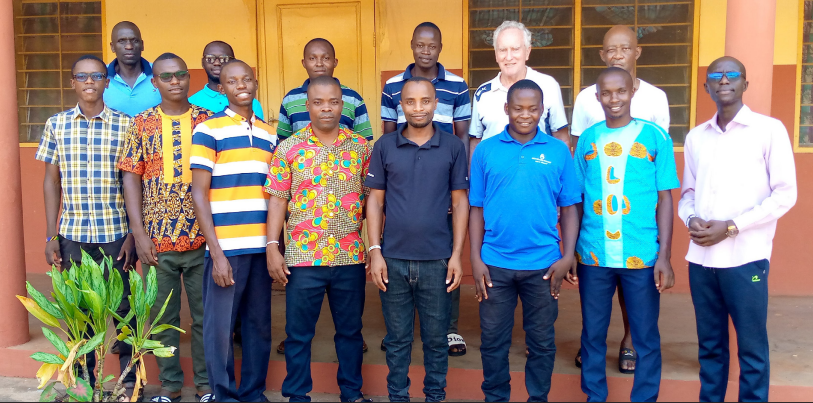
Do you have a sense that God is calling you to live your life as a religious Brother?
Contact us HERE
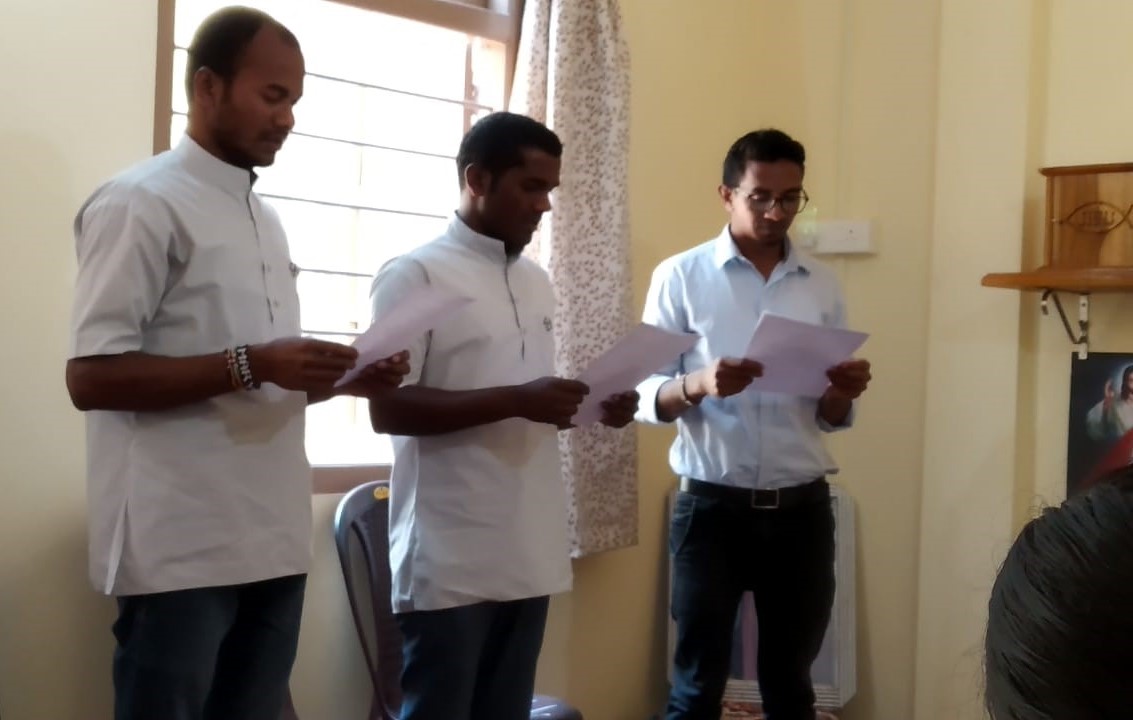
Across the world men are being attracted by the charism of Edmund Rice and the work of the Brothers.

Do you have a sense that God is calling you to live your life as a religious Brother?
Contact us HERE

The following is a timeline of important events from the historical setting and in the life of Edmund Rice.
Since the Munnar Chapter of 2008, the Congregation has been aware of the need to promote an understanding of the new story of the Universe that is emerging in the past century. There is a scientific dimension to this learning. For us there is also the very significant dimension which is living out of this new story, putting our learnings into practice in the values and attitudes that shape our lives.
These resources ar meant to introduce you to some of the science and also some of the reflections of spiritual guides in our time. It is in no way a complete or balanced set of resources but will hopefully become a starting point for further reading and reflection.
VIDEO The New Story - Brian Swimme
VIDEO Where Are We - Brian Swimme
VIDEO Birth To Earth - Brian Swimme
VIDEO Earth To Life - Brian Swimme
VIDEO Life To Human - Brian Swimme
VIDEO The Twelve Principles - Thomas Berry (1984)
Thomasberry.org - Resources by Thomas Berry
Epic of Evolution on Wikipedia
The Great Story - Resources from Connie Barlow and Michael Dowd
The History of our World in 18 Minutes - David Christian
Center for the Story of the Universe - Brian Swimme
Evolutionary Christianity - Michael Dowd
View From the Center of the Universe - Nancy Abrams & Joel Primack
The New Universe and the Human Future - Nancy Abrams & Joel Primack
International Big History Association
Grasping the Scale of the Universe
VIDEO The Origins of Life, Dr. Robert Hazen
VIDEO God In Big History, Michael Dowd
VIDEO The Fabric of the Cosmos, Dr. Brian Greene
VIDEO The Story of Life in Photographs, Frans Lanting
The Scale of the Universe - Cary & Michael Huang
Principles of the New Paradigm
Process Philosophy for Everyone
VIDEO God and the Evolutionary Mind: The God Who Beckons - Sister Joan Chittister
VIDEO Creation: Is God's charity broad enough for bears? - Elizabeth Johnson
Before 1910 the crest of the De La Salle Brothers with the phrase “Signum Fidei” had been used as the official crest of our Congregation. The General Chapter of 1910 decided that a distinctive crest should be adopted for the Christian Brothers “Fratres Christiani de Hibernia”. As a result, various designs were developed and presented to the Chapter of 1920 which chose the design of Br. Angelus Hoban.
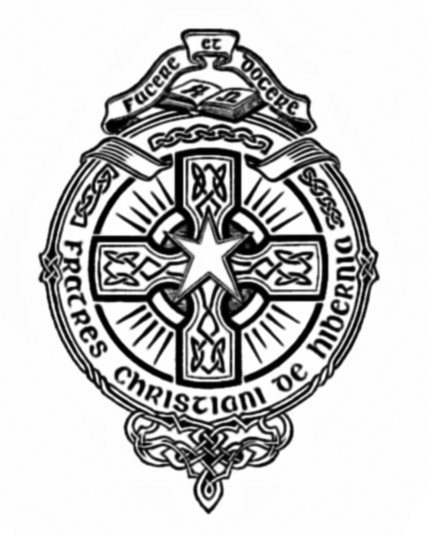 The principal features of the crest were:
The principal features of the crest were:
A variation incorporating the name “Fratres Scholarum Christiani de Hibernia” appeared in 1923 as the new title of the Congregation was to be incorporated in the new Constitutions of that year. This was to remain the official crest until the General Chapter of 1966.
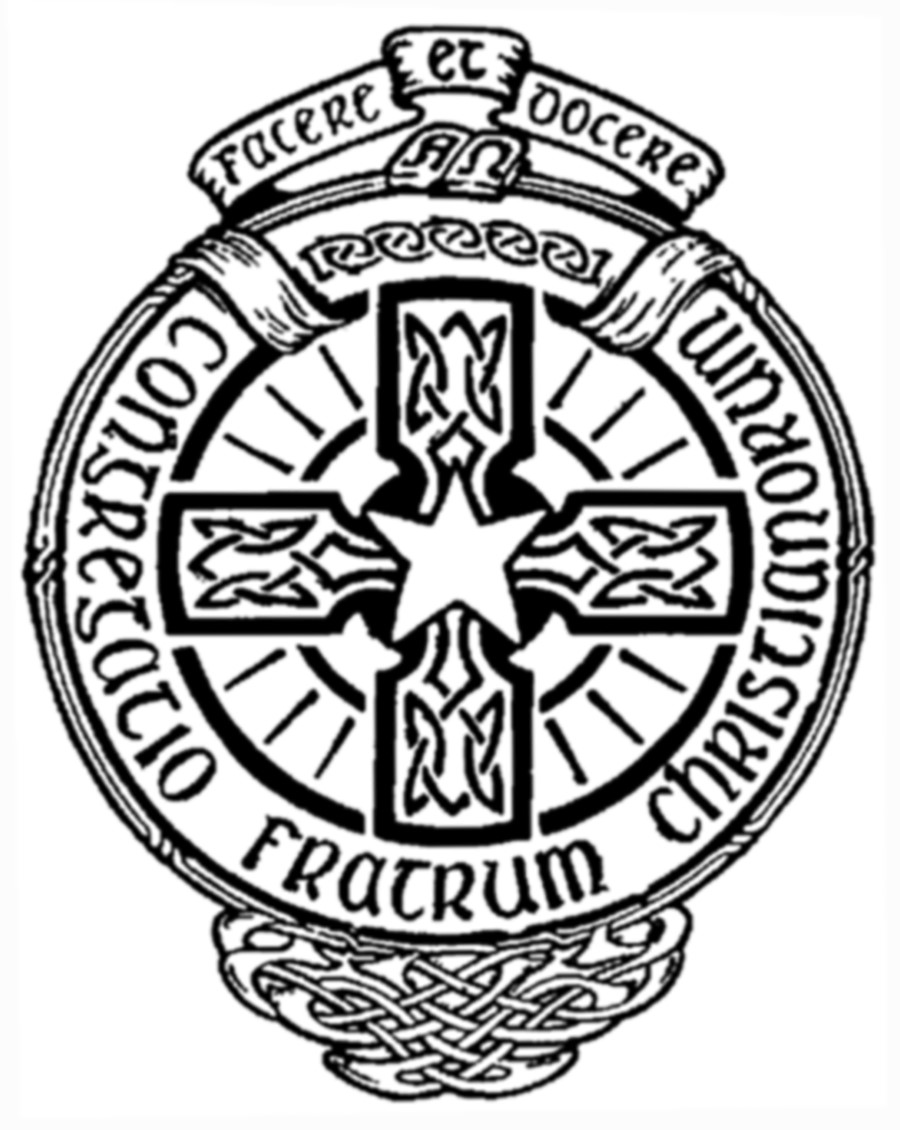
The change in title of the Congregation to “Congregatio Fratrum Christianorum” necessitated a change in the crest. The original Celtic script was changed in favour of more modern lettering. After 1972 a design by Br. Richard Kiely was accepted to coincide with the publication of the Constitutions that year. It returned to the original circular form, reintroduced Celtic lettering, and simplified some of the design of the Celtic interlacing for greater definition.

The central symbol of Christianity, i.e. the cross, is also the central to our expression of our identity as Christian Brothers. The shape of the cross takes its origin from Celtic spirituality as does our Congregation. The significance and the insights of Edmund Rice are highlighted in the stylised E which is incorporated in the logo.
As disciples of Christ, Christian Brothers are continually called to let go and leave behind all that prevents us from living faithfully the values of the Gospel and from promoting the Kingdom of God. This call and response is shown symbolically by the movement of the circle away from its regular pattern. Our call to internationally, which flows from the time of our founder and continues on to this day, is not just in geography but also in moving, as flexible and mobile followers, to meet the needs of the times. The new leaves and shoots express new life in the Congregation and signs of hope for our Brothers and for our world. Yet even the new leaves continue to express our growth through fragility, by their links to the cross and in the risks of branching out.
How can I become a Partner in this mission?
You can become a partner with us and play your part in reaching out to people who have fewer opportunities than you.
In Europe – EDMUND RICE DEVELOPMENT
Check out the Edmund Rice Development website
In Oceania – EDMUND RICE FOUNDATION AUSTRALIA
Check out the Edmund Rice Foundation website
In North America - EDMUND RICE CHRISTIAN BROTHERS FOUNDATION
Contact Colleen Noonan This email address is being protected from spambots. You need JavaScript enabled to view it.
Here is an opportunity to find out about the latest developments in Formation programmes in India.
Novitiate and Orientation Programme, Bhopal

Abinash Aind writes:
I am from Odisha. I actually wanted to join some priesthood congregation because these religious people are known to everyone in my region. I knew only priests who worked for the welfare of the society and for the poor people. I did not know anything about the Christian Brothers. I joined this congregation when I was inspired by Br. Sameer in a vocation camp. As I lived with the Brothers I came to know many things about them. I liked the way they relate with the people and their teaching. I have spent almost four years with the Brothers now and know many of them. They are very talented. They are good at playing guitar, singing, doing craft work, cooking etc. These types of things inspire me to continue in the Brothers and I also want to become like them. At the moment I am in Bhopal doing my Orientation programme. I am happy to be here.
John Dang writes:
I am 20 years old. I have five members in my family. I am from Jharkhand and its district Simdega. I studied in Brothers school in Bongera, where I was taught by many Brothers. I was really impressed by their teaching, their living style, socializing with all the people without any discrimination. When I saw these things I also felt like to do similar things with the brothers. Therefore I told Br. Sameer about my desire to join Christian Brothres and through him I joined. Now I am very happy to be in the Brothers. Presently I am in doing pre-noviciate course in Bhopal.
Mukesh Soreng writes:
I am from Odisha and my district is Sundargarh. In my family we are six members - my parents , two brothers , a sister and myself.
In 2015 I went to a vocation camp in Kalunga and there I met Br. Sameer and a few candidates. I was inspired by the words of Br. Sameer and showed interest in joining the congregation. Thereafter Br. Sameer called me for a vocation camp in Kolkata for three days. In that vocation camp some brothers came to interact with us and they told us about the brothers. They do teaching, social work and running big institutions. This conversation attracted me to join the brothers. So,I joined it in May 2015. Now I am here in Bhopal and am doing my orientation programme.
Edmund Rice House, Bajpe
 Bipin Aind, Sanjoy Lugun, Mathew Barla, Sunil Topno, Rohit Aind, Dilip Kerketta & Rashal Barla
Bipin Aind, Sanjoy Lugun, Mathew Barla, Sunil Topno, Rohit Aind, Dilip Kerketta & Rashal Barla
Bipin Aind:
I’m from Assam. I'm doing my final year degree studies from Pompei College Mangalore. I joined the Brothers in 2016. We are four children to our parents. I’m the last one. Two of my brothers are married and have their own family. My sister supports me. I like my studies and want to work with the poor in the future. I’m looking forward to joining the Novitiate in June.
Sanjoy Lugun:
I’m from from Assam. We are six in the family. My parents and three siblings. I’m doing my B.A studies from Pompei College, Aikala, Mangalore. It's four years since I joined the Brothers. I always had a desire to serve the needy. I’m quite happy to be a part of the Christian Brother family.
Mathew Barla:
I’m from from Assam. I joined the Brothers four years ago. After completing one year of English studies in Bhopal, I joined Edmund Rice Study House in Bajpe to do my Pre University studies. I’m pursuing my degree studies from Pompei College Mangalore. I’m the youngest of the six children. I’m interested in singing, music, games and cooking.
Sunil Topno:
I’m from from Jharkhand. I have two sisters and an elder brother. I’m pursuing my degree studies from Pompei college Aikala. I joined the Brothers four years ago. I’m interested in teaching.
Rohit Aind:
I come from a place called Rajgangpur in Odisha. I am doing my second B.A studies from Pompei College, Aikala. We are seven in the family. Grandparents, parents, elder brother, younger sister and myself. I love the peace in my family. I’m with the brothers for the last four years. I’m interested in guitar and football.
Dilip Kerketta:
I’m from from Jharkhand: We are five in the family. Father, mother, brother, sister and myself. I joined the Brothers in 2014. I find great support and encouragement from brothers, especially when I’m worried and disappointed. I’m doing my second year degree from Pompei College. I’m doing well in studies and co-curricular activities.
Rashal Barla:
I’m from from North Lakhimpur, Assam. I’m 23 years old. I joined the Brothers in July, 2014 in Bhopal. In the first year I learnt English and attended the orientation programme. I came to Bajpe to Edmund Rice Study house three years ago. In May I will be completing my graduation. I’m looking forward to joining the Novitiate in Bhopal soon.
Scholasticate Study House, Shillong
 L-R: Clement Topno, Shing Augustine, Ranjeet Kujur and Riborlang Nongsiej
L-R: Clement Topno, Shing Augustine, Ranjeet Kujur and Riborlang Nongsiej
I am Clement Topno from Simdega (Jharkhand). I have one brother and two sisters. I live in the study house in Shillong and I'm completing my graduation. I have another year left to finish college. My favourite game is football. In the year 2014 we had a vocation camp in our local Parish Church. I came to hear about the Brothers during this camp and wanted to join this group. I am happy here and pray that I may grow in my vocation.
I am Shing Augustine. I belong to Maram tribe in Manipur, India. I love to play music and sing. I am a fan of music. I also love to play games, especially Basketball. I like to do new things and I am open to any new ideas and activities. I love taking risks and like to learn and grow from my mistakes. I am completing my graduation this year. I am discerning concerning my vocation and pray that God will continue to guide me wherever I am.
My name is Ranjeet Kujur from Odisha. I have two elder brothers and a younger sister. I am third in the family. Before I came to join the Study House in Shillong, I was in the formation house for priesthood for 3 weeks. I left there and contacted the Brothers and joined in the year 2014. I did my English Course in the Study House in Bhopal, then my Higher Secondary from Shillong, then a year of Orientation in the Brothers in Bhopal and now I am in the second-year degree college.
My name is Riborlang Nongsiej. I am 23 years old and I am from Mairang village in Meghalaya. I have 5 brothers and 3 sisters. My father passed away recently and have only my mum. I have been with the brothers as an aspirant for the last 5 years. Now I am living in the Scholasticate and studying second year degree college. I love to play football and like to sing.
MIQ Study House, Shillong
 Sonshine Marshiangbai, Sajit Surin, Romanius Dhanwar and Anjlus Dang.
Sonshine Marshiangbai, Sajit Surin, Romanius Dhanwar and Anjlus Dang.
Hi, I am Sonshine L Marshiangbai. I come from a village called Nongkasai in Meghalaya. At home we are 5 brothers and one sister. My parents are simple village farmers and have brought us up in a loving home. I am studying in class 12 in St. Edmund’s Higher Secondary School, in Shillong. I stay in the Study House along with three other candidates. I am interested in reading magazines, playing games, travelling, meeting people and learning different cultures and traditions. I pray and hope to be a brother and work for people who are poor.
My name is Sajit Surin and I am from Jharkhand. I am doing the English Course in the Study House in Shillong. I completed my class 12 from the Junior college in our village. My goal is to learn English, complete my studies so that I can do well in the mission of the Christian Brothers. I like playing football and basketball. After I finish the English course, I want to go to the Study House in Bajpe and do my graduation. Hope and pray that God will guide me in my journey.
I am Romanius Dhanwar. I am from Assam which is situated in the northeast of India. We are four members in our family. My mother, elder sister, elder brother and myself. I came to hear about the Brothers when they came to our village for a vocation camp. On hear about this story and the life of the Brothers I wanted to join Religious Life. I am now in the Study House in Shillong doing the English Course. I like being here and love to play football and read story books. I am looking forward to doing my class 11 and 12 in Bajpe after completing the English Course.
My name is Anjlus Dang. I was born in a small village named Domtali, in Jharkhand. I completed my class 10 education at the local school. During a vocation camp I got interested and inspired by listening to the story of Blessed Edmund Rice and the work of the Brothers in India. Therefore, last year I decided to come to the study house in Shillong to learn the English language which we hope to complete by the end of May 2019. I plan to go to the Bajpe Study house to do my 11 and 12. I am happy here and pray that God will strengthen me to do well.
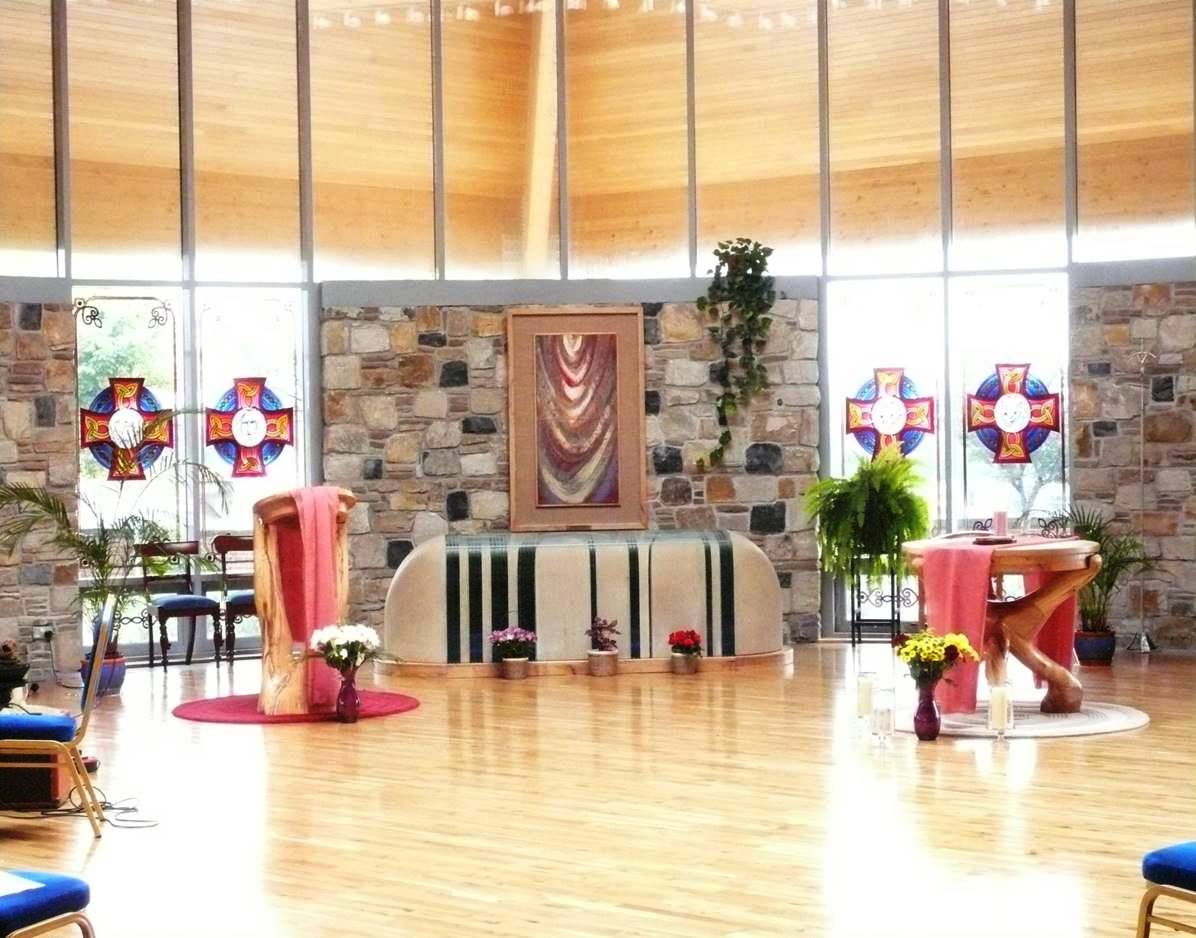
The Chapel
The Edmund Rice Chapel with its circular shape sits dramatically on the hill of Mount Sion. Inside the Edmund Rice Chapel is the tomb of Blessed Edmund Rice.
Made of sandstone and glass the tomb has Edmund Rice's name etched in the side and top in Ogham, the ancient Irish alphabet. Glimpses of Edmund's coffin - in which are his remains rest - are visible through the slits in the glass of the top of the tomb. Visitors are welcome to touch the stone of the tomb as they pause for prayer and reflection.
A popular story of Edmund Rice was that during his contemplation of his future, he wondered about going to Europe to study and seek ordination. His sister-in-law, Joan Power, drew his attention to some poor boys outside his window and told him that out in the streets of Waterford was his monastery.
Similarly, today visitors can look over Waterford from inside the Chapel, and allow the vista of Waterford, the World and the Cosmos to direct their reflections. In turn, Waterford, the World and the Cosmos can be affected by the activity of meditation, prayer and reflection in the Edmund Rice Chapel.
Visitors may also choose to avail of the Peace Garden between the Chapel and the monastery. It offers an oasis with its flowers and plants, bench seating, the stations of the cross and a cosmic walk.

Edmund Rice Heritage Centre
An interactive Heritage Centre, opened in 2008, tells the story of Edmund Rice, the history of Ireland and the growth of the Congregations throughout the world.
The museum provides opportunities for visitors to:
• Live the Edmund Rice Story through an atmospheric and interactive experience
• Become immersed in 18th century Waterford through audio-visual and multi-media creations
• Visit the 19th Century school room
• See the Brothers' and their colleagues' work throughout the world
• See the reconstructed face of Edmund Rice
Special tours and curriculum materials for schools are available
Community and Ministries:
An international community of Christian Brothers lives at Mt Sion, offering hospitality to all who come to visit or stay.
Email: This email address is being protected from spambots. You need JavaScript enabled to view it.
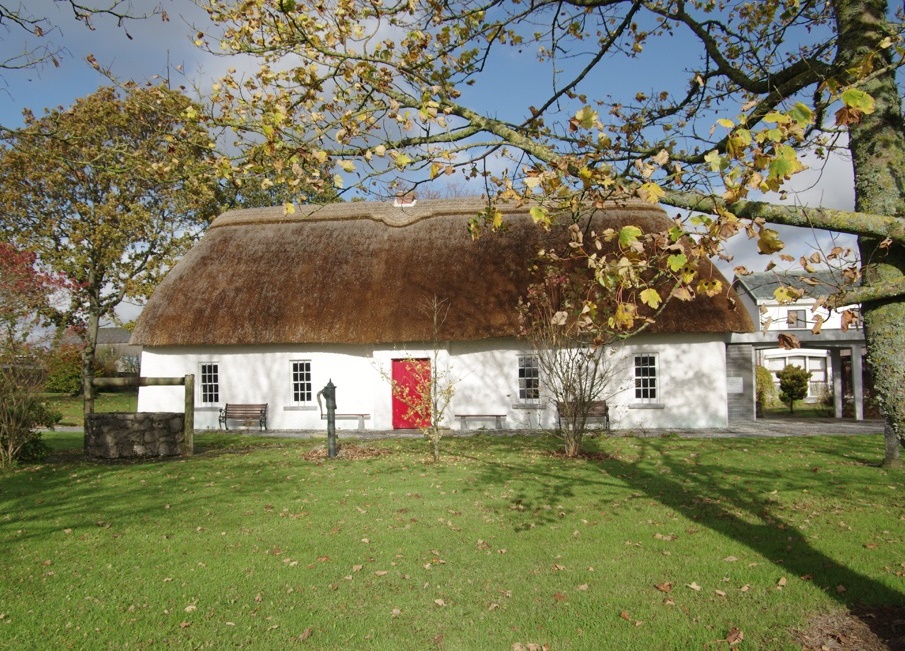
Blessed Edmund Rice, founder of the Christian Brothers and Presentation Brothers, was born to Robert and Margaret Rice, prosperous tenant farmers, at Westcourt, Callan, Co. Kilkenny, on 1st of June 1762.
He was the fourth of seven brothers, and had two stepsisters, Joan and Jane Murphy, from his mother’s first marriage. The Penal Laws against Catholics were still in force in Ireland. County Kilkenny fared better than many places because of the tolerance of John Butler, the Protestant Duke of Ormonde who resided in Kilkenny Castle.
As a result, enterprising Catholics, such as Robert Rice, were enabled to rent farmland from tolerant Protestant landlords at reasonable rates. So Edmund was fortunate in a land where the majority of Catholics were “hewers of wood and drawers of water”.
The thatched house "Westcourt" in which Edmund was born on 1 June 1762, is almost 300 years old. The six roomed house consists of a kitchen, parlour, breakfast room and three bedrooms. Of particular interest is the bedroom in which Edmund Rice was born.
Also on the site is the Edmund Rice Memorial Chapel and a large visitors’ centre.
Opening Hours
1 April - 30 September
10:00 am to 1:00 pm and 2:00 pm to 6:00 pm
1 October - 31 March
10:00 am to 1:00 pm and 2:00 pm to 5:00 pm
Closed
Good Friday and Christmas Day
Telephone: +353 (0) 562 5993 / +353 (0) 562 5141
Since 1802, when the first school began in Waterford, Ireland, Edmund Rice education has grown in over 20 countries.
Across the world, over 170,000 students are educated to build a better world.
Edmund Rice Education Beyond Borders (EREBB) is an International network of Catholic schools educating young people from many different faiths and cultures.
In over 20 countries we endeavor to promote global solidarity and offer a transformational education for justice and liberation.
We are inspired by the teachings of Jesus, Gospel values and the spirit of Edmund Rice. Click below to visit the website
If you are interested in knowing more about Edmund Rice schools networks:
The lifeline of a living Congregation parallels the life of the Church. Founders and Foundresses are often influenced by movements and trends in the history of the Church. Where people suffer the Church usually responds. Certainly this was true of Edmund Rice. He always read and met “the signs of the times.” In the early years of the Congregation, there were times when the schools were closed and handed over to the civic authorities because of the dreaded Typhoid fever or Cholera epidemics which periodically swept through Ireland.
In 1816 the Brothers were just completing the building of the famous North Monastery in Cork when they were asked to allow the building to be used for those dying of Typhoid fever. A Catholic doctor donated beds and installed windows throughout the building and for the next year their new school became a temporary hospital. It was 1818 before the school was again open to the admission of boys.
The early spring of 1832 was unusually fine in Ireland. But the people were worried. They had heard that a vigorous form of Asiatic or Blue Cholera had run through Asia and was on its way across Europe. Many hoped that Ireland's situation as an island on the western edge of Europe would save it. But when the cholera reached Paris and London, moving westward, prayers were offered that the dreaded scourge would not reach that far.
In March of that year cases were reported in Dublin and Belfast. The Cholera had arrived.

Dublin was an old city and since the Act of Union of 1800 it was a very poor city. The sanitary condition of the city had not been attended to for a long time. With poor living conditions and unsanitory water supplies, the disease raged through the poorer parts of the city which were crowded with a population sunk in indescribable misery. Every morning a fresh list of the dead was posted on the doors of the churches. Quarantine was encouraged to slow the rapid spread of the disease and to quell public hysteria. There was fear and depression all over the country. Between fifty and sixty people died each day in Dublin. The Archbishop of Dublin, the clergy and the religious of the city helped in nursing and comforting the victims.
Soon, however, the cholera spread outside the city. Public authorities everywhere took measures to meet this dreadful scourge. Temporary hospitals were set up in addition to those already existing. Belfast, Cork, Drogheda, Thurles, Galway, Dungarvan became in quick succession scenes of awful suffering.
Edmund Rice directed that his Brothers should help wherever they could. In Thurles the Brothers gave up their monastery and schools to the Board of Health to be used as hospitals and they looked for lodgings for themselves. In Dungarvan the Brothers likewise surrendered their house and schools and went to live in the empty house of a lady who had fled the country.
The cholera came to Cork a month later than Dublin. There was panic in the city. The number of deaths in Cork was so great that some people lost all hope and refused to go to the hospital. In Cork also, the Brothers helped. The Sisters of Charity, then only five years established in Cork, did heroic work, as did Archdeacon O'Keefe and the famous Fr. Francis O’Mahony.
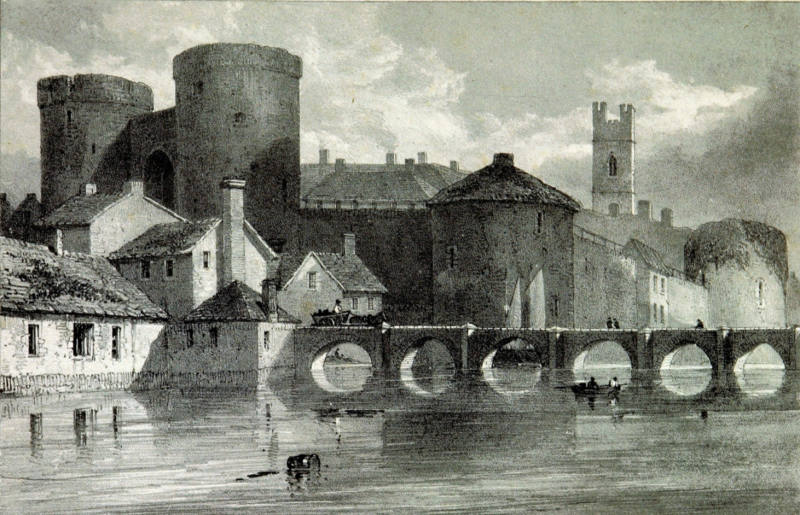
There was a shortage of hospital accommodation in Limerick. A Board of Health was established. Barrington’s, the principal hospital in the city, could not cope. Edmund Rice advised his Brothers to help all they could. They placed their house, their new school (just built) and themselves at the service of the Board. The schools were closed until further notice. Sexton Street schools were fitted up as a hospital. The upper and lower rooms, each 64 feet long, were supplied with beds, the women upstairs and the men downstairs.
On May 26th the Cholera set in with great malignity. On the night before, the city had been covered with a deep and damp fog that almost suffocated the people. The first Cholera patients were brought to St. Michael’s Hospital (Sexton Street Schools). Limerick had no nuns at the time. The Presentation Sisters did not come to Limerick until 1837 and the Sisters of Mercy in 1848. Two brave Clare ladies, Miss Reddin and her niece, Miss Bridgeman (aged 19 years) took up residence in the parlour of the monastery and superintended the school hospital, day and night. These two great ladies had charge of a hostel for street girls. These girls worked side by side with them as nurses in the hospital. Some years later, Miss Bridgeman entered the Sisters of Mercy and became famous for her heroic work for the soldiers in the Crimean War, 1854.
Barrington’s and St Michael’s hospitals both filled rapidly. The cries of the people were heard daily in various parts of the “English” and “Irish” town. The appearance of the hospital carts in the streets spread the wildest confusion. Labourers with carts collected manure from the lanes and spread slack lime on the footpaths and the channel ways to try to counter the spread of the disease. Houses were whitewashed, sentries were placed at the entrances to towns. Bedding and blankets were distributed to the poor. Wealthy families went to the seaside or to friends in the country. No mail coaches ran either into or out of the city. There were hearses on the streets every hour of the day. Many poor people died on their way to hospital.
The Brothers of Sexton Street went at all hours among the male patients in Barrington’s and St Michael’s. They sat by their bedsides, rubbed down aching limbs and prepared them for the Last Sacraments. There were ten to fifteen deaths each night. The cholera lasted six weeks in Limerick.
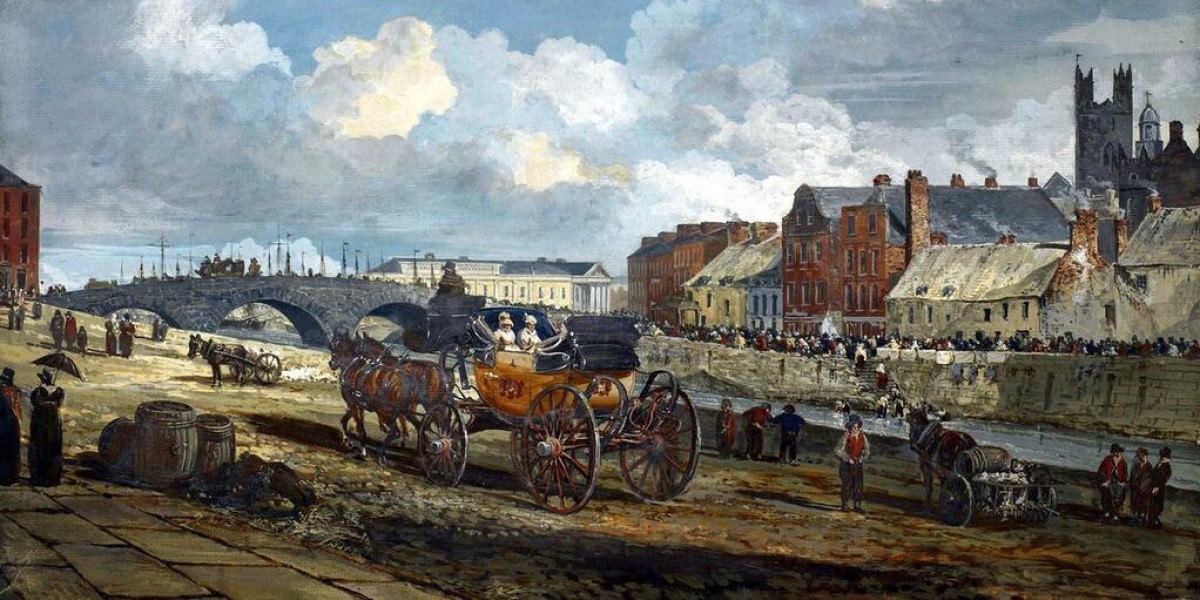 Brother Virgilius Jones who had lived with some of the Limerick Brothers recorded the following: “From the details which have come down to us of the labours of the Brothers during the epidemic in Limerick, it is clear that no pen could do justice to their charity and patient endurance, in all their ministrations. All day long they were to be seen at the bedside of the sufferers attending to every call, to soothe every pang, using every appliance possible to keep down the burning fever or to ease their tortured limbs. The night also found the Brothers at their post, the silence of which was only broken by the heart-rending cries of the sufferers, calling aloud for the Brothers by their names, and whose very presence at the bed-side seemed to have a soothing effect." He goes on to describe the conditions of the locations, the entrance crowded with coffins awaiting burial and with coffins waiting for corpses, the Brothers stepping over 10 or 15 bodies each morning.
Brother Virgilius Jones who had lived with some of the Limerick Brothers recorded the following: “From the details which have come down to us of the labours of the Brothers during the epidemic in Limerick, it is clear that no pen could do justice to their charity and patient endurance, in all their ministrations. All day long they were to be seen at the bedside of the sufferers attending to every call, to soothe every pang, using every appliance possible to keep down the burning fever or to ease their tortured limbs. The night also found the Brothers at their post, the silence of which was only broken by the heart-rending cries of the sufferers, calling aloud for the Brothers by their names, and whose very presence at the bed-side seemed to have a soothing effect." He goes on to describe the conditions of the locations, the entrance crowded with coffins awaiting burial and with coffins waiting for corpses, the Brothers stepping over 10 or 15 bodies each morning.
The six-month siege of cholera in Limerick found 525 patients being cared for, and out this number there were 225 deaths. A later Superior General, Brother Louis Hoare, was seen carrying out corpses on his back.
Towards the end of the outbreak the Board of Health saw the necessity for a convalescent home for patients recovering from cholera. The Brothers gave over their other schools in Clare Street. It was a big building and had housed 300 pupils.
Edmund proudly praised the work of the Brothers in a letter he wrote to Mother Austin McGrath in Dungarvan on June 12th, 1832: "Our Limerick Brothers are attending the poor cholera patients in the Hospitals. They give a frightful account of the ravages it is making there... Sixteen sent dead out of the school - which has been turned into a hospital - one morning. I am not one bit in dread that a Priest, Nun or Monk will sink under its direful hand." While his trust in Providence was not realised as regards the priests – two died, one in May and the other in November - no Brother or nurse in St Michael’s Hospital caught the disease.
(Acknowledgement of the sources: John E. Carroll, Barney Garvan, Columba Normoyle, Al Houlihan)
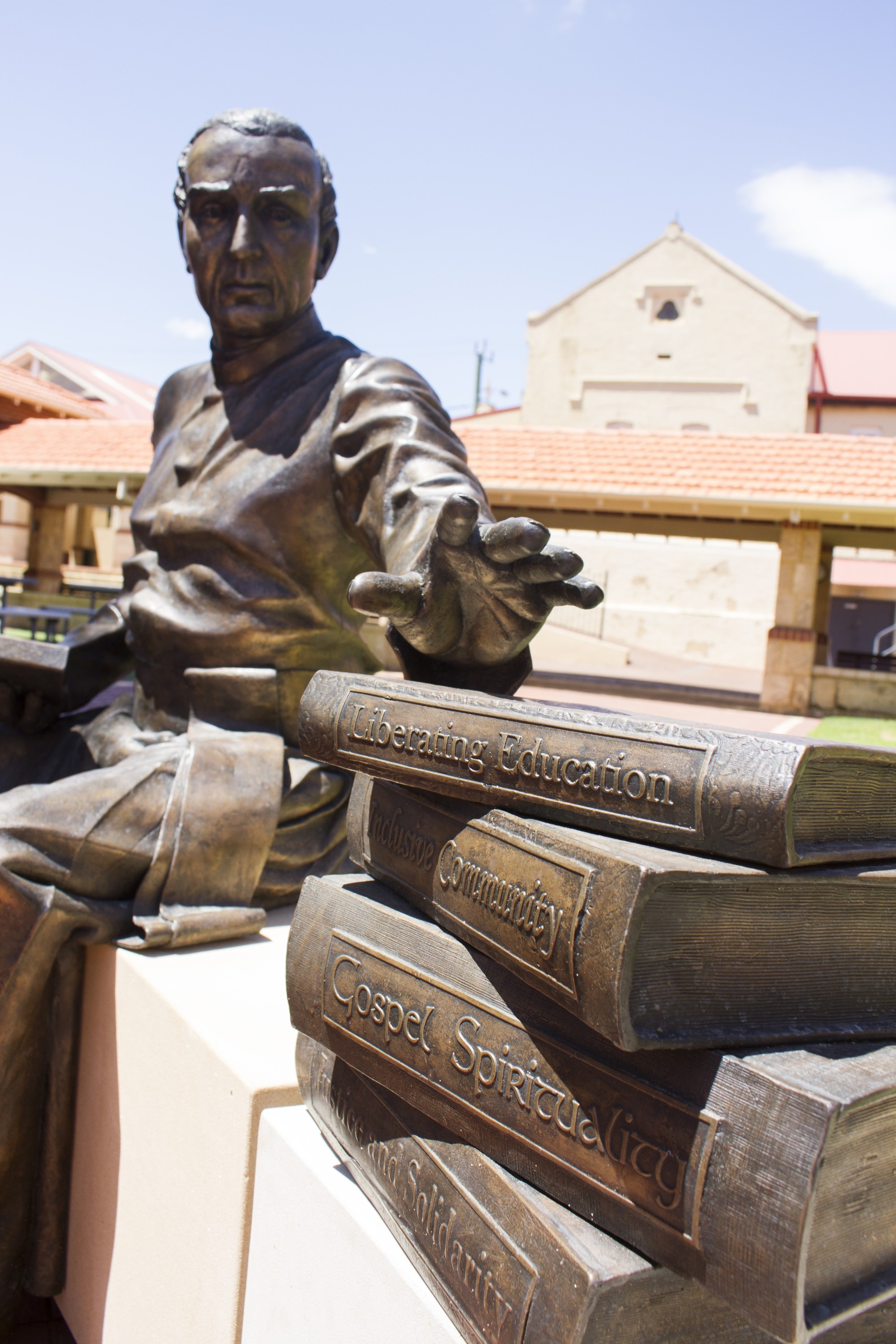 Sitting on a bench in the centre of the College Cloisters at CBC Fremantle (Australia), 'Eddy', as he's known to many boys at the College, is a stunning bronze sculpture that provides a constant reminder of the impact each one of us can have on the world.
Sitting on a bench in the centre of the College Cloisters at CBC Fremantle (Australia), 'Eddy', as he's known to many boys at the College, is a stunning bronze sculpture that provides a constant reminder of the impact each one of us can have on the world.
Crafted for more than a year by renowned Fremantle sculptor Greg James in his studio at J Shed, Edmund is dressed in a traditional cassock, reflecting the importance of faith in his life, with well-worn shoes indicating his life amongst the people. In his right hand he holds a small book titled 'The Life of Nano Nagle', which is a nod to the value he placed on the work of the founder of the Presentation Sisters. His left hand rests on a stack of four books, each bearing one of the four EREA Touchstones, as an ever-present reminder of what anchors the College community in an ever-changing world and of the lasting worth of a holistic faith education.
In an interview when the project was launched in 2019, the Principal Mr. Dominic Burgio said “We’re trying to make sure that Edmund’s legacy is maintained and that the boys understand the roots of the school, which is why the students learn about him as early as year seven”.
During breaks, Eddy is never far from the action, always joined by boys eating their lunch or having a chat on his bench of Donnybrook standstone. His presence is felt throughout the Cloisters, as his spirit lives on through the College's work, both on campus and in the wider world.
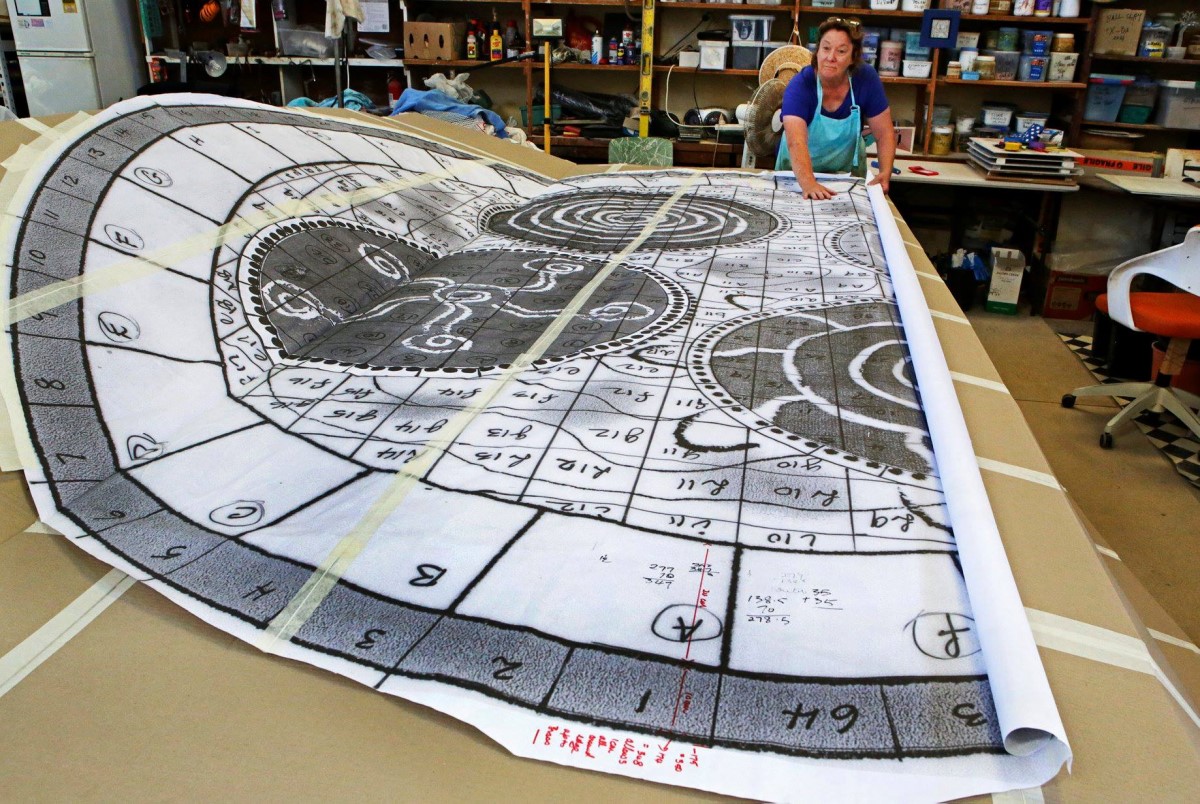 At Eddy's feet is a spectacular, hand-crafted mosaic, produced by local artist Jenny Dawson. Each tile tells its own story, and together, they form an eye-catching account of the College's history. In the centre, swimming in sky blue swirls symbolising the College's proximity to the ocean and the port city of Fremantle, are the Indigenous symbols for each of the Touchstones, in recognition of the original custodians of the land on which the campus has stood for more than a century. The artwork is bordered by 32 tiles containing key moments in CBC's history, including photos of graduating classes, academic records and other documents from the archives.
At Eddy's feet is a spectacular, hand-crafted mosaic, produced by local artist Jenny Dawson. Each tile tells its own story, and together, they form an eye-catching account of the College's history. In the centre, swimming in sky blue swirls symbolising the College's proximity to the ocean and the port city of Fremantle, are the Indigenous symbols for each of the Touchstones, in recognition of the original custodians of the land on which the campus has stood for more than a century. The artwork is bordered by 32 tiles containing key moments in CBC's history, including photos of graduating classes, academic records and other documents from the archives.
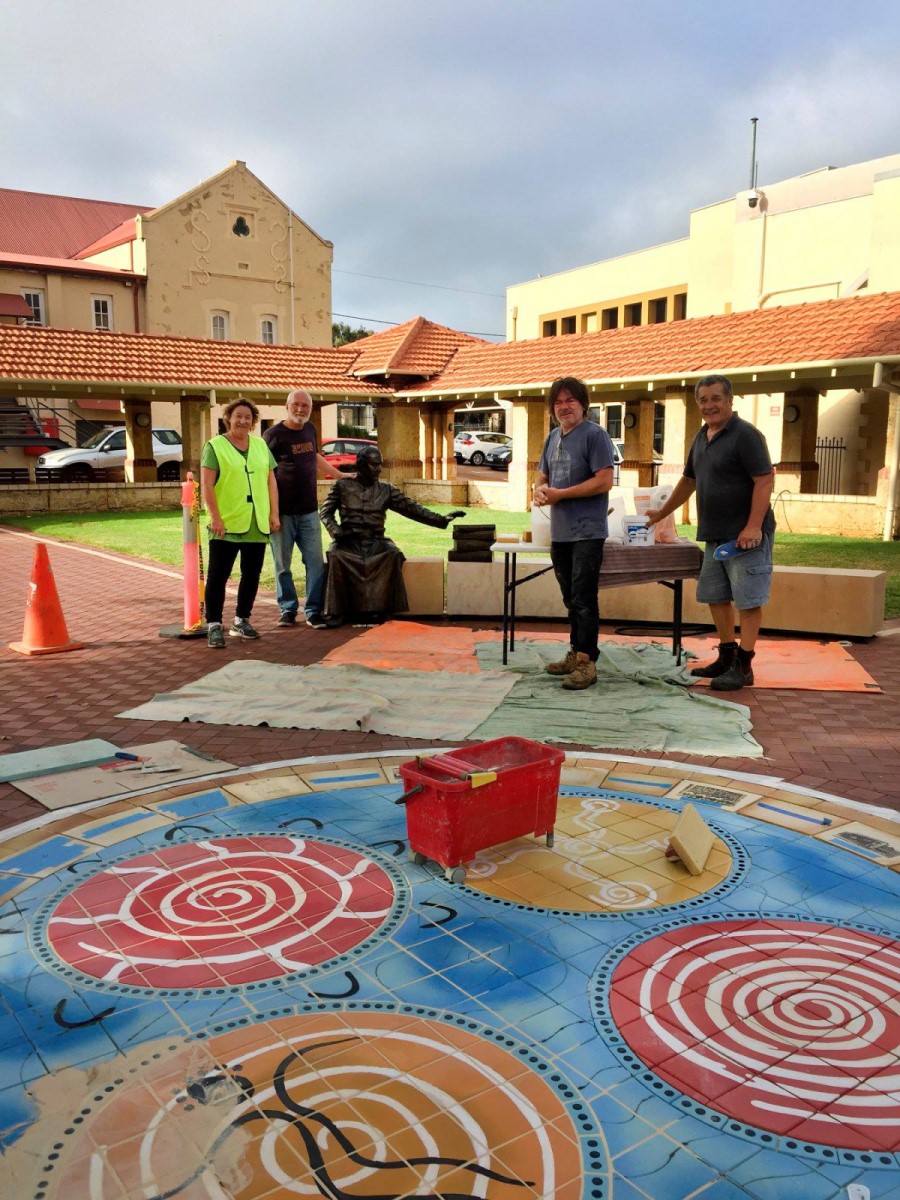 Ms Dawson says the mosaic was an incredible test of her ceramic skills, and believes it was “touched by the hand of god” as a big black circle mysteriously appeared through the clay on one of the tiles.
Ms Dawson says the mosaic was an incredible test of her ceramic skills, and believes it was “touched by the hand of god” as a big black circle mysteriously appeared through the clay on one of the tiles.
Together, the sculpture and the mosaic are constant visual reminders of the centuries of history and tradition of the College, and the exciting future of tomorrow's gentlemen.
Check out the College website cbcfremantle.wa.edu.au
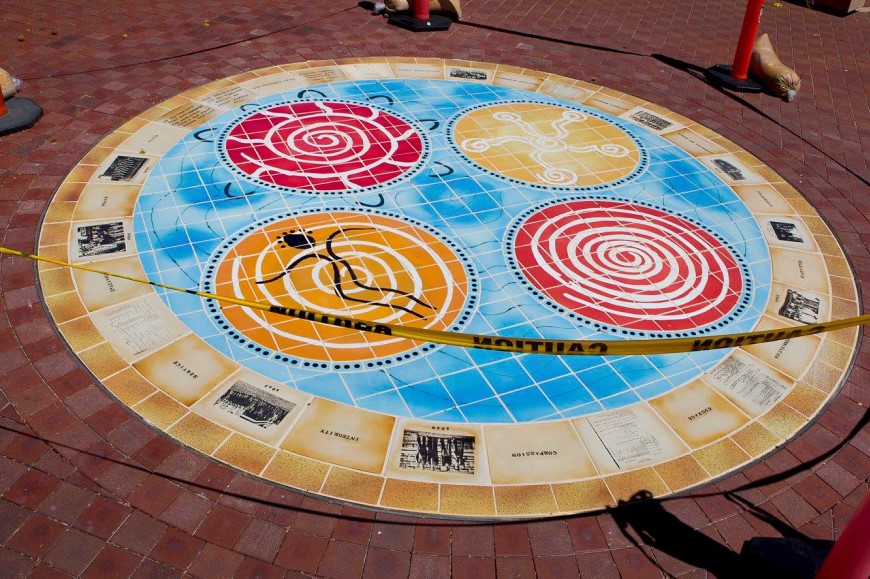
An Italian artist, Norberto Pasqualini, looks at the life of Edmund Rice
| Edmund grew up on a prosperous farm in Callan, in Co Kilkenny, Ireland.. He knew horses and cows and pigs and was familiar with all the sights and sounds and smells that are part of a farmyard. Working on a farm helps a person to keep his feet on the ground. Edmund learnt this lesson early in his life and was later known for his balanced personality. | 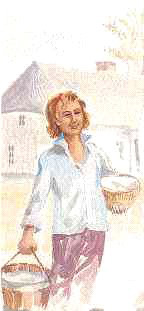 |
|
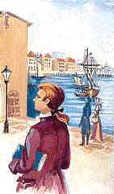 |
Edmund's future lay in commerce. His uncle invited him to join his business in Waterford. Edmund is shown as a young, energetic young man walking along the quay on the Suir River at Waterford. He eventually took over the business, which involved provisioning ships and exporting cattle. The future looked rosy for this young man who was fast becoming very successful. | |
| In his mid twenties and at the top of his profession, Edmund married his wife, Mary. The artist depicts them on their wedding day as they face life together. Their cup was brimming over with happiness. | 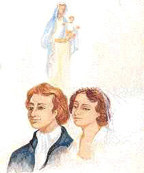 |
|
 |
|
|
| Edmund’s newly-born daughter, named Mary after her mother, was a sickly child. Edmund devoted himself to caring for her, aided by his step-sister, Joan, who became his housekeeper | 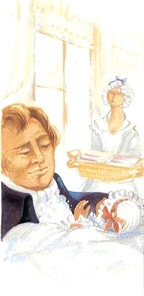 |
| After the death of his wife, Edmund turned increasingly to God. He read the bible frequently, seeking insights about the direction his life would now take. As a businessman, he was particularly attentive to what the bible said about money. He began to think of ways in which he could use his wealth for the good of others, especially the poor. | 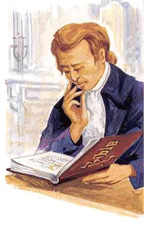 |
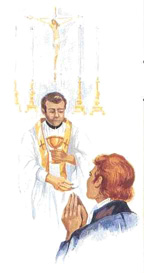 |
A second source of strength for Edmund was frequent attendance at Mass and the reception of the sacraments. Jesus became a reality in his life |
| Edmund began to give generously to the poor of Waterford, supporting mant needy families | 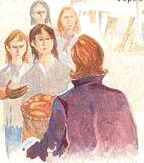 |
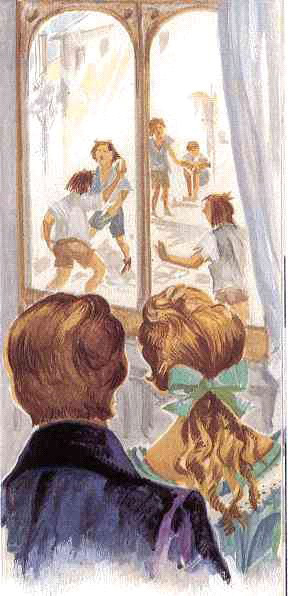 |
A significant moment in Edmund’s life was a comment made to him by a lady friend. She knew that he was thinking of becoming a monk in a monastery in Europe, but she said to him as they watched the poor, ignorant children playing in the street below the room where they were talking that it could be God’s will that he devote himself to the lifting up of the poor boys, so much in need of a Christian education |
| Edmund began to think of founding a religious congregation for the education of poor boys. He sought advice from friends he trusted. | 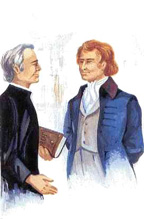 |
| In 1802 Edmund took the plunge and began teaching the poor boys of Waterford, first in a stable and then in the school rooms he built at Mt Sion. Many considered his scheme could not succeed but, trusting in Providence, he began his work. At first he had some paid helpers but when these gave up because of the difficulty of the work, he continued alone. Then some generous young men joined him, becoming the nucleus of his congregation of religious educators | 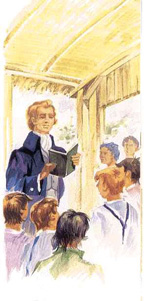 |
|
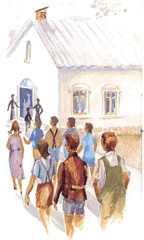 |
The boys, unused to discipline, took a while to settle but eventually their good conduct and studious habits won the admiration of all in Waterford. Edmund counselled his brothers: “Have confidence. The good seed will grow up in the children’s hearts later on.” | |
| Edmund built a bakery and tailor shop to meet the needs of the poor students who came to his school. He employed bakers to make bread each day for those who needed food and tailors to provide the poor with respectable clothes. Edmund’s bakery and tailor shop still stand in the grounds of Mt Sion. | 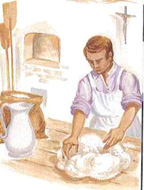 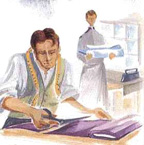 |
|
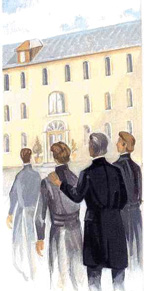 |
|
|
| Edmund and the brothers were always aware of the need the poor had for the simple but essential things of life. He provided food for them in the towns where the brothers worked. One who knew him well said, "he was father and mother to the poor". | 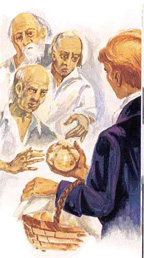 |
|
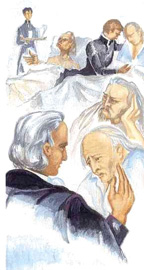 |
Alert to the needs of others, Edmund turned some of his schools into hospitals when the plague broke out in some parts of Ireland. The brothers served the sick, Edmund being sure that God would safeguard his brothers from the dangers they were facing in the work they were doing. | |
| Edmund was a regular visitor to the gaols, comforting those who were imprisoned. Men about to be hanged would ask that Edmund stand beside them as they faced death, such was their trust in him. | 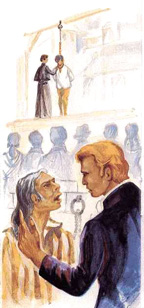 |
|
 |
Edmund opened his whole heart to Christ present and appealing to him in the poor. His trust in God was absolute. “Providence is our inheritance” was one of his mottos. Through his personal efforts and the work of his brothers, he reached out to the poor in Ireland, England and Gibraltar. Today Edmund’s brothers carry on his vision in 27 countries throughout the world, attempting to be true to the words of Jesus in the gospels: “I have come that they may have life.” Edmund died in 1844. He was beatified by Pope John Paul II in 1996. His feast day is 5 May, the anniversary of the day when the foundation stone of his first school, Mt Sion, was laid. |
‘Revelation and Commitment’ is the title of a recent artistic installation by Jenny Steiner at St. Patrick’s College Ballarat.
The work represents Edmund Rice and Mary Power viewing the wayward boys on the wharf in the city of Waterford.
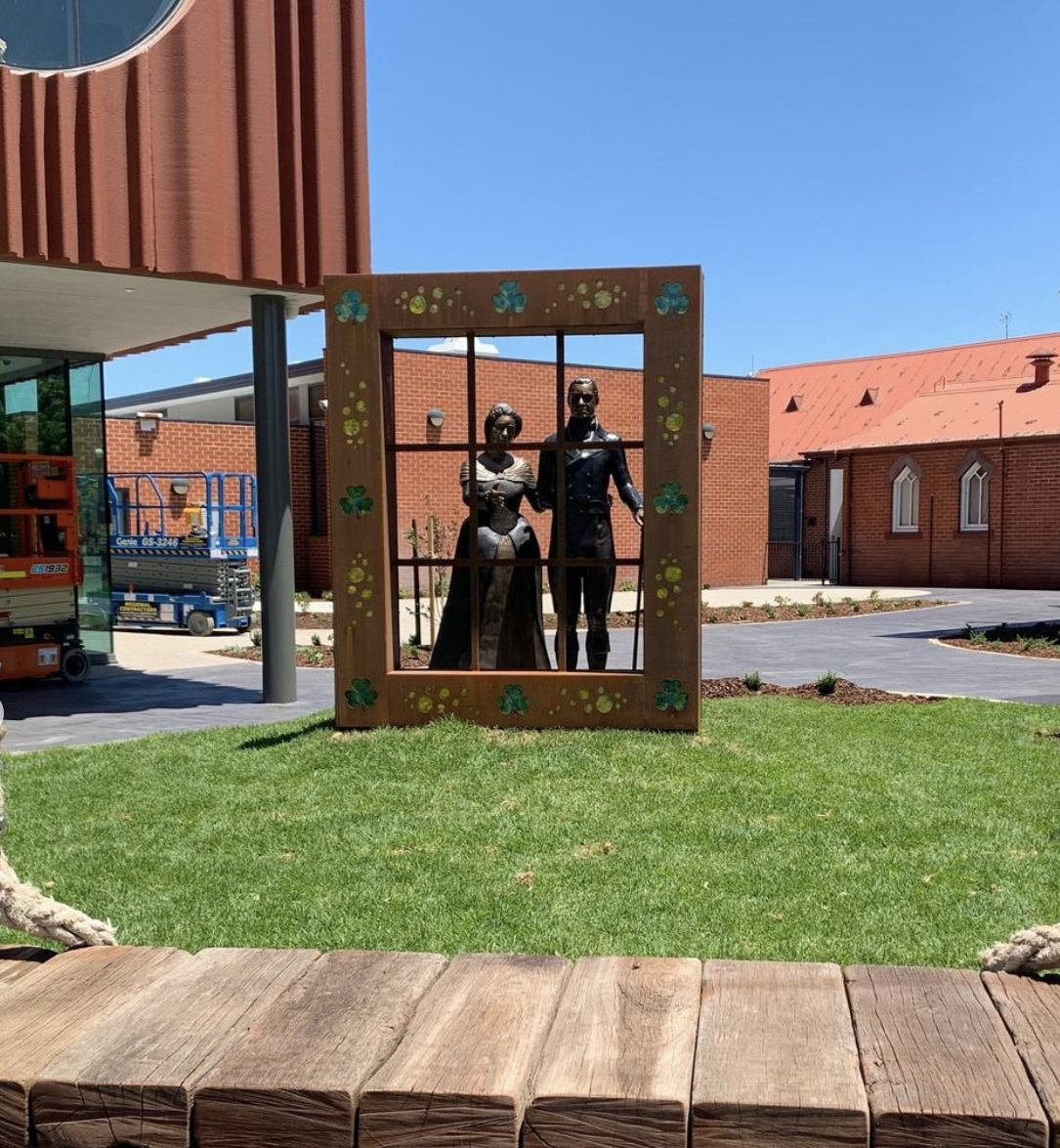
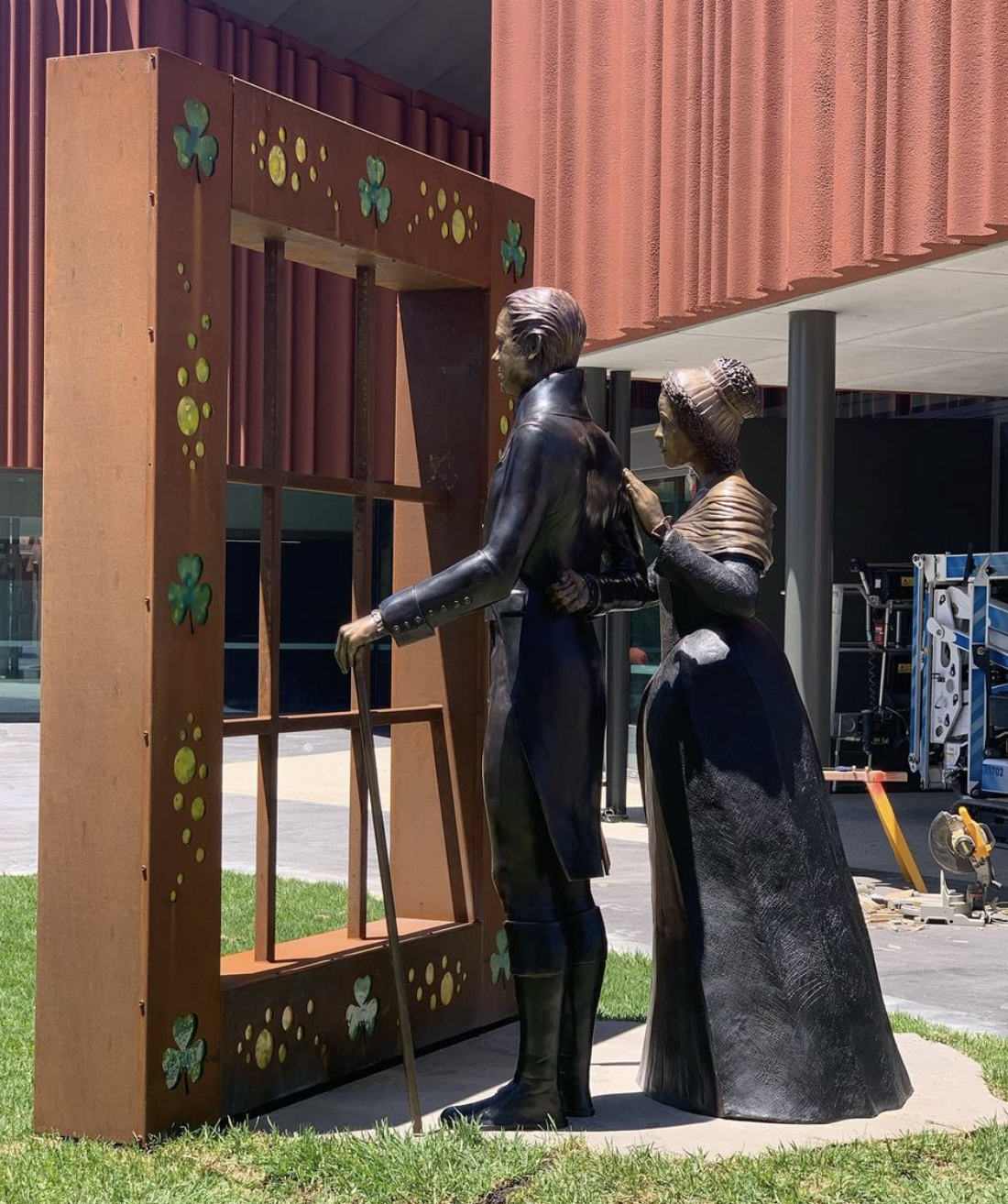
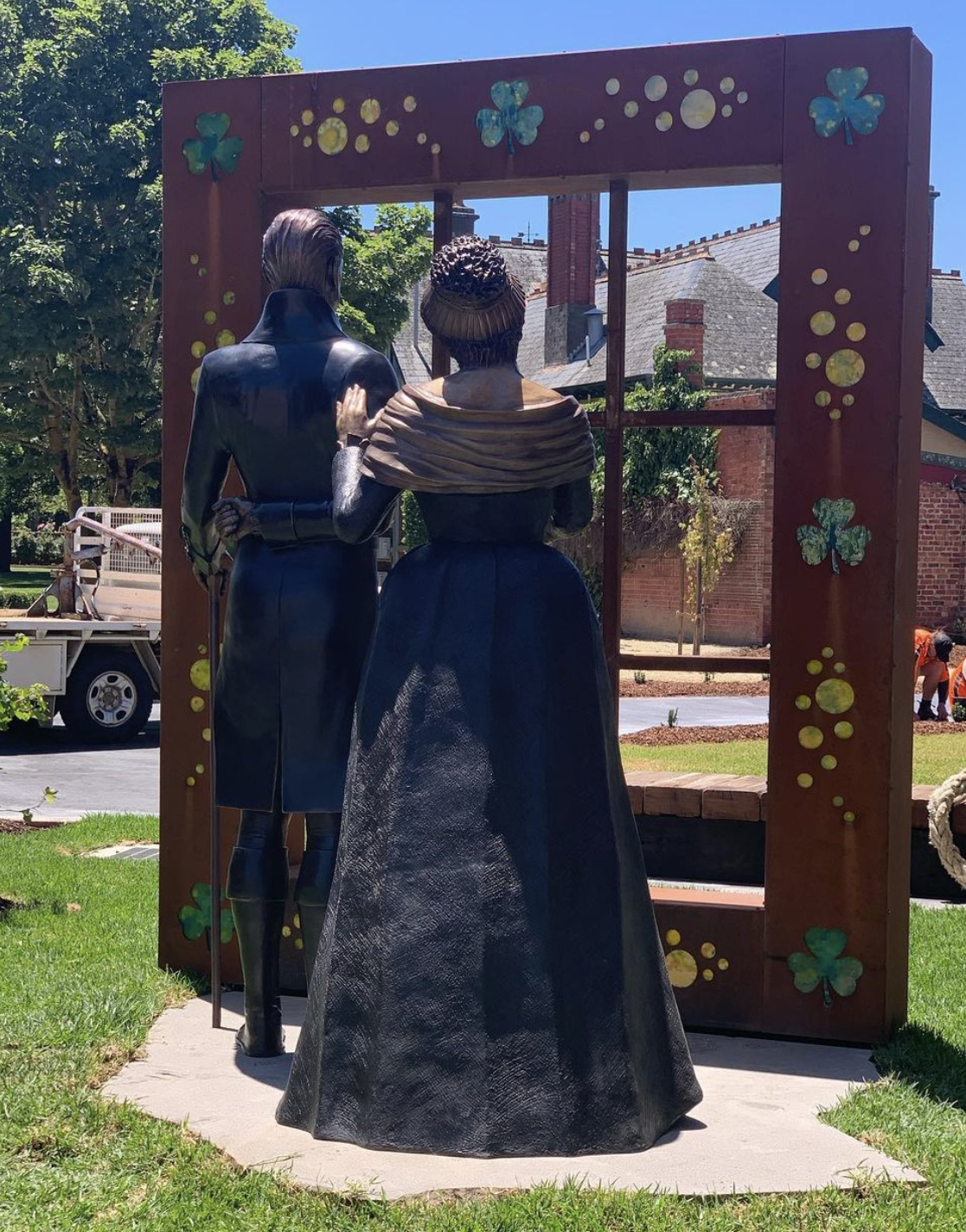
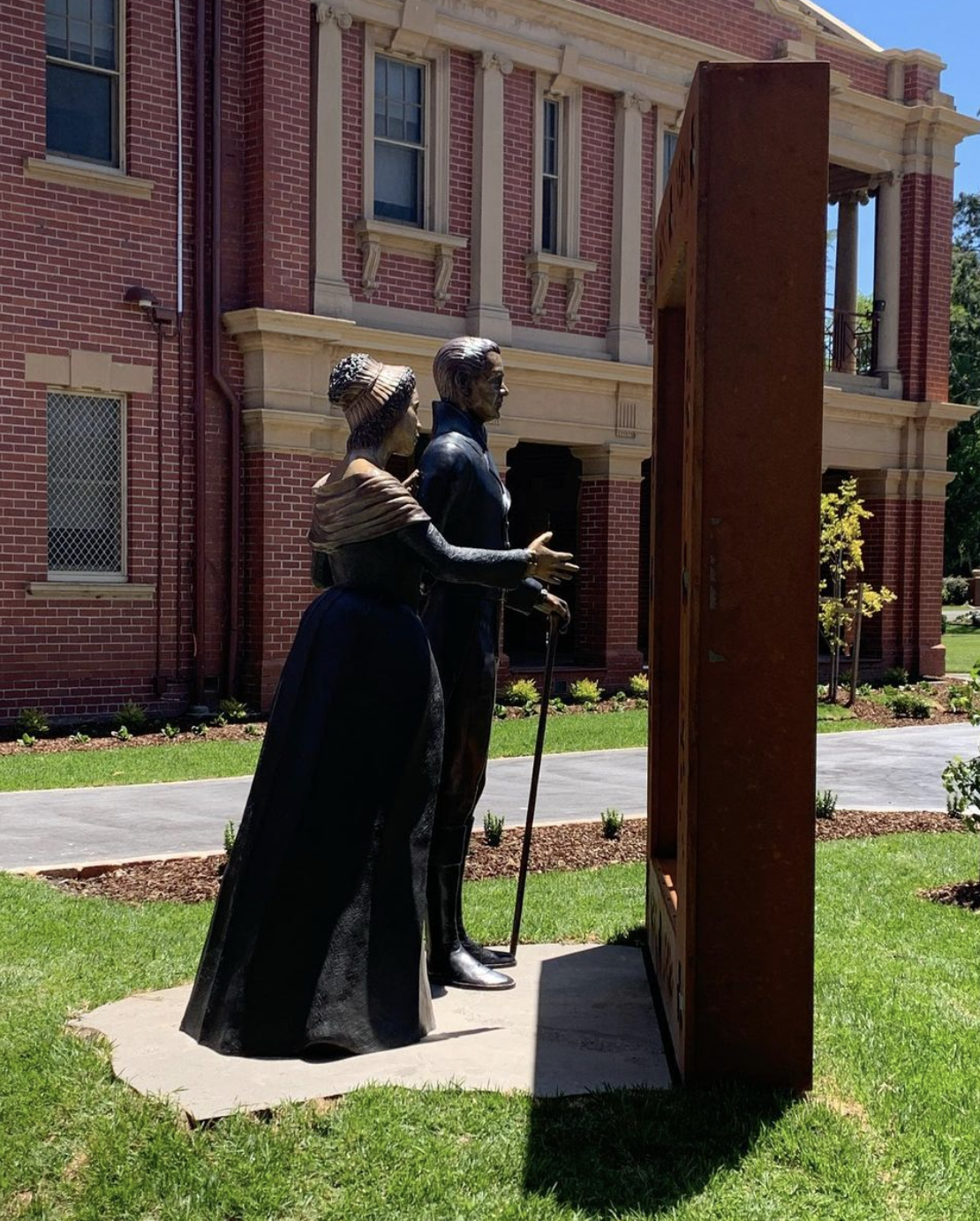
On October 6, 1996, the Church officially recognized the tremendous attributes of Edmund Rice and his virtuous life, as Pope John Paul II beatified him in a ceremony at St. Peter’s Square in Vatican City.
Sunday, October 6th, 1996, offered us a special window in Rome on the world of Blessed Edmund Rice. There were people gathered with the Christian Brothers and the Presentation Brothers from far and wide joyfully united in the recognition by the universal Church of the Brother they loved. This anniversary year offers us another window on our world and our Church. We need the eyes to see what is emerging in the different perspectives which are offered to us.
We can reflect again on Edmund’s experience of what he saw as he gazed from the window with Mary Power on the city of Waterford. “There’s your Melleray [monastery]” she said. What he saw and what she said changed him and his responses to that world. He was particularly moved to consider what could be done to confer a new sense of dignity and liberation on the poor people of Waterford.
He allowed God to search his heart – his very soul – to show him a new and, for him, unexpected way of changing the world around him. In particular, it was the plight and disadvantage of poor people that moved him. He wanted to find a way, like the Presentation Sisters before him, of educating and empowering the children of poor people. This was integral to his pathway into God. He realised that the Church – that messenger of Christ in the world – could only be true to itself when it would welcome all people to its places of worship and community.
The business man turned educator. The man of financial means spent it all for others. The family man founded a new community of Brothers. The new enterprise and mission moved from commerce to education for faith and for life.
As the beatification banner unfurled in Rome twenty-five years ago, we were asked to look into the window of the life of Edmund Rice. We were asked to ponder the question, “who are you Edmund Rice?” Now in 2021, it is appropriate that we look into that window again and ask that same question. We are looking into the mystery of God, once manifested in him. Crucially we are also looking into that self-same mystery in ourselves through our connection with Blessed Edmund and with something of the gift of his perspective and vision.
Edmund’s mind was made up. “Everything was adverse; everywhere was difficulty; but in Edmund Rice there was that happy combination of those noble qualities which eminently fitted him for gigantic action, and made him less consider the magnitude of obstacle than the means of overcoming them. It was at this critical stage in his vocation that he showed the unbounded trust in Providence that became such a feature of his spirituality in later years. He sold his business and with a worldly imprudence, reproved by his brother, Father Rice, and with no group of disciples to assist him opened his first school in a stable in New Street.”
Three windows at different times now offer very different perspectives. If we are still seeing – or imagine that we are seeing – the same things, then there is something radically out of joint. Our world and our Church today can still be viewed through the eyes of Blessed Edmund. The responses we make with the spirit of Jesus and the vision of Edmund must now be attuned to the twenty-first century.
The need for education – a new education for new awareness – as a means to enhancing human dignity and potential is as important today as ever it was. The need for an education that opens possibilities to explore the mysteries of life as the pathways of God is more relevant than ever. This will be done as a new consciousness emerges in us from new and awakened awareness.
Our window on the world today opens up the vista of a pandemic world with all its frailty and fragility. The world is one increasingly characterised by climate change which introduces us as human beings to the awareness of ourselves as contributing to the destruction of our only home which we share with all that is alive.
Our world is still one of great inequality and one that seeks to resolve different senses of injustice with violence and destructiveness. Unfortunately, it is a world in which the most vulnerable can be exploited, dishonoured, and even disposed of.
However true, all of that may be too pessimistic and too dark for some. It is also true that many women and men are looking through the windows of life today and making a creative difference and offering positive contributions. They do so in the hope that the infinite potential which belongs to all of life can emerge and bring forth “life to the full” (John 10:10). Like Edmund Rice we, too, must look through our windows on life and respond to what we see.
Blessed Edmund Rice, in writing his earliest rule for and with his Brothers, was clear about the spirit that should guide them in their lives and in their work. In 1832 he wrote:
The spirit of this Institute is that spirit of faith,
Which inspires its members to view
Nothing but with the eyes of faith,
To do nothing but with a view to God,
and to ascribe all to God;
At all times entering into
The sentiments of holy Job
“The Lord gave” to me,
“the Lord hath taken away” from me:
“As it hath pleased the Lord, so is it done:
Blessed be the name of the Lord!”
Today, as followers of Blessed Edmund, we are called to live in the wonder, the beauty and the mystery of life with the perspective and appreciation of the One we call God. We are living in a time which calls for great changes. It is also a time when nothing less than life itself – in all its forms and expressions – is at stake. This is why we recall twenty-five years ago and this is our window for today, and the view invites us to respond with energy, compassion and creativity.
Our mission today continues to be one of instilling hope into the lives of those we are privileged to serve. Let us do so with the same spirit and enthusiasm that led Blessed Edmund to begin his work some 219 years ago. Let us do so in faithfulness, believing that God is with us, as we carry out the mission begun by Blessed Edmund that has been passed down to each one of us.
Let us be bearers of hope in today’s world, as we continue this sacred mission entrusted to our care.
Creator God,
we thank you for the gift that Edmund Rice gave to the world in
his love and passion for the poor and unprivileged in his day.
Today, in our own time and place may we dedicate ourselves to
make a difference in our world and leave nothing undone to carry on
the wonderful vision of Edmund Rice.
As educators like him, may we bring Christ’s compassion,
presence, liberation and joy to those we teach and serve.
Lord God, make us more conscious of your presence in our lives
that we may have the courage and strength
to live out our vocation as educators of youth.
This prayer we ask through Jesus Christ, our Lord.
Amen.
Deeply aware of the Father’s providential presence in his life, Edmund Rice was moved by the Holy Spirit to open his whole heart to Christ present and appealing to him in the poor.
He was given the grace to respond by identifying through Christ with the poor in order to evoke in them a deep awareness of God’s loving presence.
His example attracted others to share his Gospel insight and response in an apostolic religious community which mainly through Christian education would raise the poor to an awareness of their dignity as children of God.
International Spirituality Conference, August 1982.
Here is the link to the letter recently distributed re. the upcoming Zoom calls: